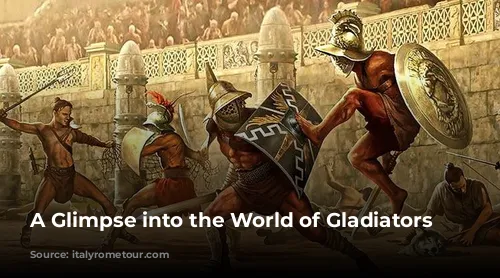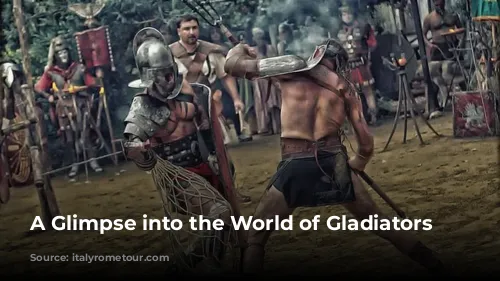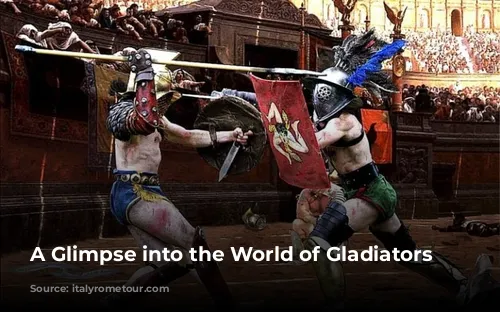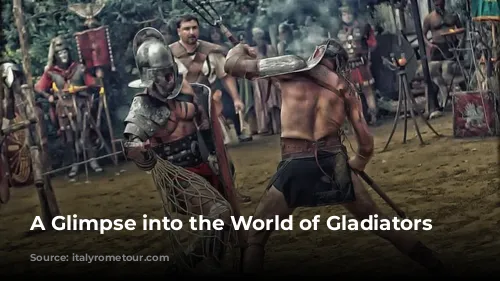The Colosseum and other Roman amphitheaters were once the stage for gladiators, men who fought for the entertainment of the masses. But who were these brave warriors and what really transpired within the arena walls?
From Etruscans to the Roman Empire
The tradition of gladiator duels originated with the Etruscans, an ancient civilization who deeply influenced Roman culture. This practice was quickly adopted by the Romans, who embraced the spectacle of these epic battles. The first recorded gladiator show took place in 264 BC, and by 105 BC, these events had become a public spectacle.
The Lives of Gladiators
These fighters, usually aged 20 to 35, were a diverse group. They could be professional warriors, inexperienced recruits, convicts, criminals, slaves, prisoners of war, or even free men—regardless of race or sex.
Gladiators trained rigorously at specialized schools, the most renowned being the Ludus Magnus. These schools housed fighters in cells organized by skill and prowess. Under the watchful eye of a magister, gladiators were categorized and trained to perfection. Their daily routines included intense workouts and a diet rich in vegetables, legumes, honey, and dairy products. To fuel their energy before entering the arena, they consumed a honey focaccia.
The Spectacle in the Arena
Each gladiator show began with a grand parade, showcasing the financier and his attendants carrying the day’s program. The gladiators themselves entered with their weapons, followed by those sentenced to death. They would then salute the emperor before preparing for battle.
Types of Gladiators and Their Battles
There were many different types of gladiators, each with their unique weapons and fighting styles.
- The Mirmillone: Heavily armored with a helmet and integral shield, they were formidable opponents.
- The Thrace: Skilled with a curved sword and a lightweight shield, they were known for their agility.
- The Secutor: This heavily armored gladiator, wearing a padded helmet, was known as the pursuer.
- The Retiarius: Armed with a net, dagger, and trident, he was the lowest class of gladiator. However, he was popular with the crowd, as his bare tunic allowed spectators to see his face.
After a duel, the victor would face the crowd, awaiting their verdict. The spectators, with a gesture of the hand, would decide the defeated gladiator’s fate: a thumbs up meant life, while a thumbs down meant death. However, the final decision rested with the emperor or the organizer of the show.
Beyond the Gladiatorial Combat
The gladiator fights were often inspired by mythological tales. There were also grotesque situations staged to entertain the crowd.
Venationes, fights between gladiators and animals, were another popular spectacle. Lions, tigers, leopards, elephants, bears, deer, wild goats, and camels were among the animals featured in these events. The lion was particularly popular for its fierceness.
The Life of a Gladiator
The life of a gladiator was difficult and risky. They fought for their lives, freedom, and glory, and the Roman people held these warriors in high esteem. The strength and courage of the victorious gladiator were admired, and they often became famous figures.
Convicts and prisoners of war were particularly sought after for their fierce nature, forged in years of struggle and suffering. Many came from distant lands, such as Numidia, Thrace, and Germany, and willingly embraced this dangerous path.
While many gladiators were slaves or former slaves, some were free-born individuals who fought under contracts. They were often seen as outcasts, labeled as “infames” (people of bad reputation).
A New Understanding of Gladiator Combat
Recent research has shed light on the nature of gladiator battles, revealing that they were not mere bloodbaths, but organized fights with specific rules enforced by referees. Although gladiators wore sturdy helmets, wounds on skulls suggest that some were killed after losing their matches, a brutal end to their careers.
The Rise and Fall of Gladiator Shows
The popularity of gladiator shows soared during the Roman Empire. The Flavian dynasty, starting with Emperor Vespasian, constructed the Colosseum, the largest and most famous amphitheater in the world. However, in the 4th century, Emperor Constantine I, having embraced Christianity, banned gladiator shows.
Despite their often-violent nature, gladiators held a certain sex appeal and were admired by both men and women.
This fascinating look into the world of gladiators paints a picture of these warriors, their lives, their battles, and the culture that surrounded them. While the brutality of the arena is undeniable, there is also a sense of fascination and admiration for these individuals who fought for their freedom and glory.







